What is the Secret to Growing Marigolds: Tips for Vibrant Blooms
Planting marigolds can brighten up your garden with their vibrant colors. These cheerful annuals are not only lovely to look at but also quite easy to grow. The secret to growing marigolds is proper watering and soil conditions. Make sure to water them at the base and only when needed. Avoid getting water on the blooms, as this can shorten their lifespan.
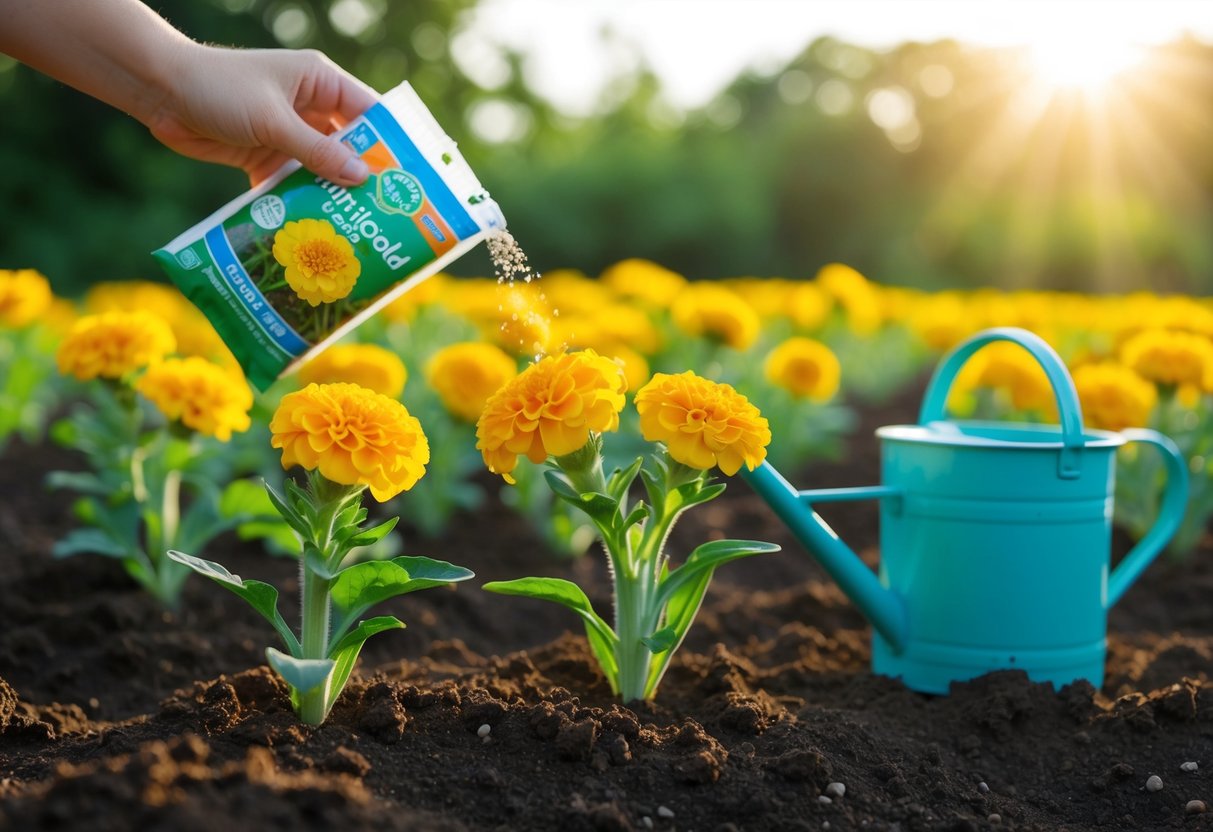
Marigolds thrive in good garden soil that’s not too acidic. Keeping the soil pH roughly neutral will make these flowers happy. They do well in soil that’s not overly rich in organic matter, preferring a leaner type to flourish.
To ensure your marigolds bloom beautifully, thin out seedlings and space them properly. French marigolds should be spaced 8 to 10 inches apart, while larger African marigolds need 10 to 12 inches of space. This helps them grow without overcrowding. By following these simple tips, you can enjoy a garden full of stunning marigolds.
Getting to Know Marigolds

Marigolds bring vibrant color to gardens and are cherished for their ease of growth. There are several types, each with a rich history and unique characteristics. Understanding these can help you select the best marigolds for your garden.
Types of Marigolds
Marigolds come in a few main types: French, African, and Signet.
-
French Marigolds (Tagetes patula) are compact and bloom profusely. They thrive in pots and small garden spaces.
-
African Marigolds (Tagetes erecta) are taller, with large blooms. These are perfect for creating bold statements in any garden.
-
Signet Marigolds (Tagetes tenuifolia) are smaller and have a lighter, citrus fragrance. They are often used to add a delicate touch to borders.
Each type offers different colors and bloom sizes, so you can mix and match to create a vibrant display.
Marigold History
Marigolds have a fascinating journey across continents. They originated in the Americas and caught the attention of European explorers. When Spanish and French explorers brought them back to Europe, they quickly gained popularity.
The French marigold earned its name due to its popularity in France, despite its American origin. Over time, marigolds spread across the globe and became a symbol of warmth and cheer, appreciated in festivals and gardens alike. Today, they are loved for both their beauty and ease of cultivation.
Understanding Marigold Varieties
Marigold varieties vary widely in shape, size, and color. Tagetes plants are generally hardy, preferring warm climates and full sun.
French marigolds tend to be more compact, with a height of about 6-18 inches. On the other hand, African marigolds can be much taller, reaching up to 3 feet. Signet marigolds are known for their delicate foliage and bright yellow blooms.
When selecting marigold varieties for your garden, consider the size, bloom time, and intended location. With so many options, you can find the perfect marigold to complement any garden space.
Planting Marigolds
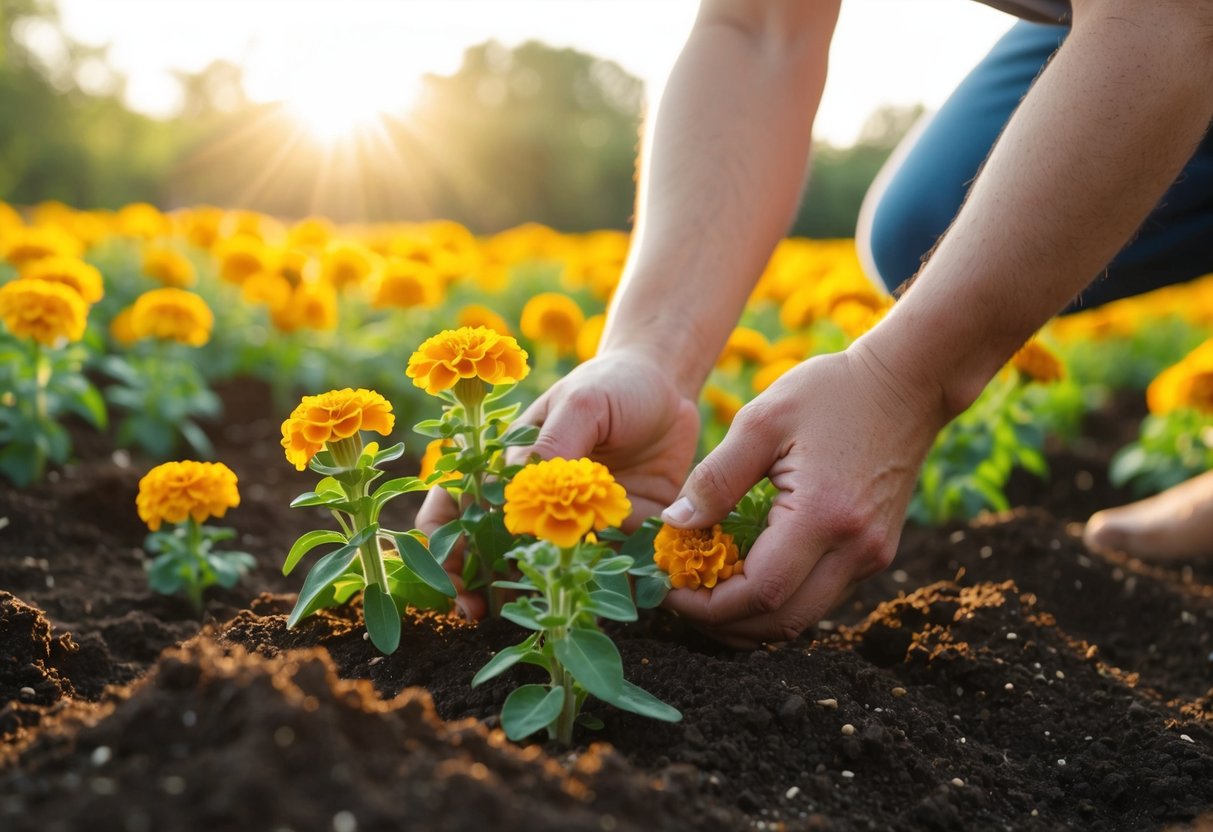
When planting marigolds, it’s important to choose the right soil, sow seeds correctly, and handle transplants with care. By considering these factors, you’ll set up your marigold garden for success.
Choosing the Right Soil
Marigolds thrive in well-drained soil. You don’t need soil rich in organic matter; in fact, they perform better in leaner conditions. Check that your soil has a neutral pH between 6.0 and 7.0. If you’re unsure, you can use a simple soil test kit from a garden center.
For container planting, use a soil-based potting mix. This provides stability for the plants. Avoid heavy soils that hold too much water, as they can be detrimental to marigold roots.
Sowing Marigold Seeds
To start from seeds, wait until the threat of frost passes. Sow marigold seeds about one inch apart and cover them with approximately a 1/4 inch of soil. If you’re planting different types, remember that French marigolds can be started this way, but African marigolds are slower and often bought as young plants.
Keep the soil moist, but not too wet, to ensure proper germination. Once seedlings are visible, thin them to prevent overcrowding.
Transplanting Tips
If you’re using transplants, ensure you water each plant thoroughly after placing it in the garden. Space African marigolds 10 to 12 inches apart, while French and signet marigolds need 8 to 10 inches of space.
Transplants usually adapt well if you maintain optimal soil moisture. Be gentle when handling the root ball to reduce stress on the young plants.
Marigold Care Essentials
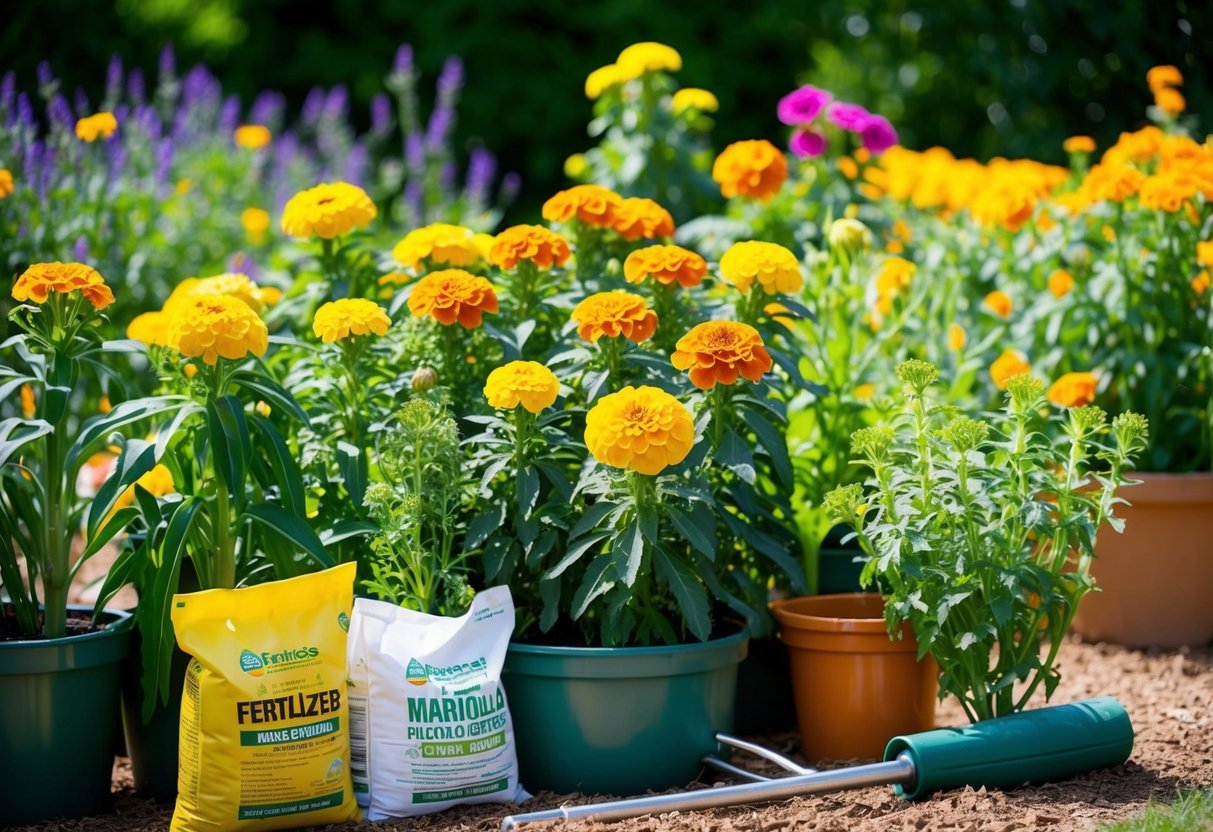
To keep your marigolds vibrant and healthy, focus on providing ideal conditions such as proper sunlight and watering, applying suitable fertilizers, and practicing effective pruning and deadheading. Each aspect ensures your marigolds bloom beautifully throughout the season.
Sunlight and Watering
Marigolds thrive in full sun, which means they need at least six to eight hours of direct sunlight each day. Choose a spot in your garden that gets plenty of sunshine.
When it comes to watering, marigolds prefer soil that is evenly moist but not soggy. You can achieve this by watering them thoroughly once the top inch of soil feels dry. During hot or dry spells, you might need to water more frequently. It’s important to avoid getting the foliage wet while watering to prevent fungal diseases.
For best results, use a soaker hose or drip irrigation system, which helps direct water straight to the roots.
Fertilizing Your Marigolds
Marigolds don’t require heavy fertilization. Too much fertilizer can lead to lush foliage but fewer flowers. Instead, opt for a balanced, slow-release fertilizer at planting time.
Over the growing season, supplement with compost to boost soil health and provide additional nutrients. A simple method is to apply a thin layer of compost around the base of each plant.
You can also use a diluted liquid fertilizer every few weeks if your marigolds appear to need an extra boost.
Pruning and Deadheading
Regular pruning and deadheading are crucial for encouraging marigolds to produce more flowers. Deadheading involves removing faded or spent blooms by snipping them off just above a set of leaves.
Pruning also keeps the plants bushy and prevents them from becoming leggy. Cut back any long or straggly stems to promote a fuller appearance.
Take care of any yellowing leaves by gently removing them. This not only improves the appearance but also prevents potential disease issues. By keeping up with these practices, you’ll enjoy an extended flowering period and a healthier plant overall.
Protecting Marigolds from Pests and Diseases
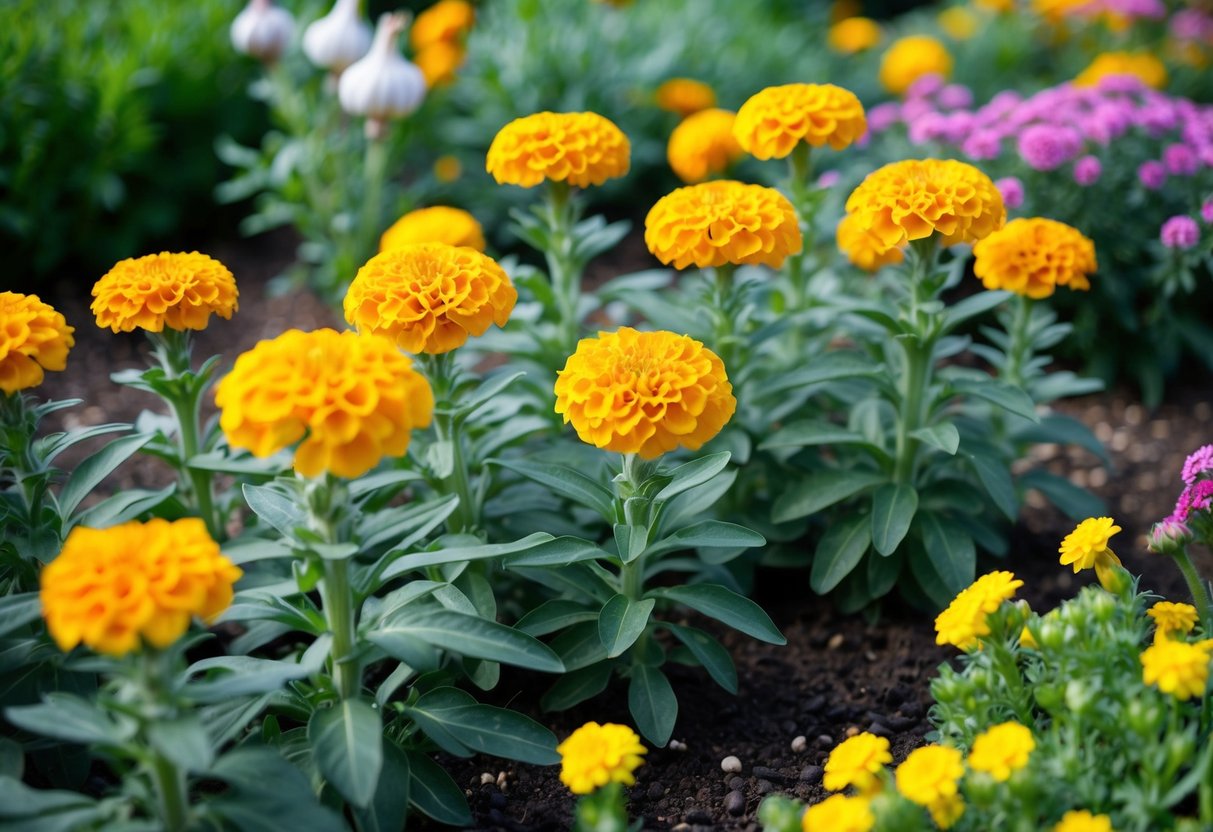
Keeping your marigolds healthy involves understanding the pests and diseases that can affect them. You can ensure their vibrant blooms last by taking preventative measures and treating issues quickly.
Common Marigold Pests
Marigolds can suffer from several pesky invaders. Aphids, whiteflies, and spider mites are among the most common ones. These tiny insects can sap the strength of your marigold plants by sucking sap from the leaves and stems.
Aphids and whiteflies often gather on the undersides of leaves. Spider mites, on the other hand, are harder to spot but leave tiny webs among the foliage.
Fighting Marigold Diseases
Marigolds are susceptible to several diseases, including powdery mildew and root rot. Powdery mildew looks like a white dust on leaves and can weaken your plants. Root rot is often caused by overwatering, leading to wilting and yellowing leaves.
Other diseases like Verticillium wilt can be devastating, affecting water transport in the plant.
Prevention Strategies
To keep marigolds healthy, practice good garden hygiene. Remove debris and old plant materials that can harbor pests and diseases. Rotating crops can prevent soil-borne diseases like nematodes from becoming established.
Keeping plants well-spaced ensures good airflow, reducing the risk of diseases like powdery mildew. Water at the base of the plants to keep foliage dry and less susceptible to diseases.
By staying vigilant, you can enjoy strong and healthy marigold plants.
The Wider Benefits of Marigolds
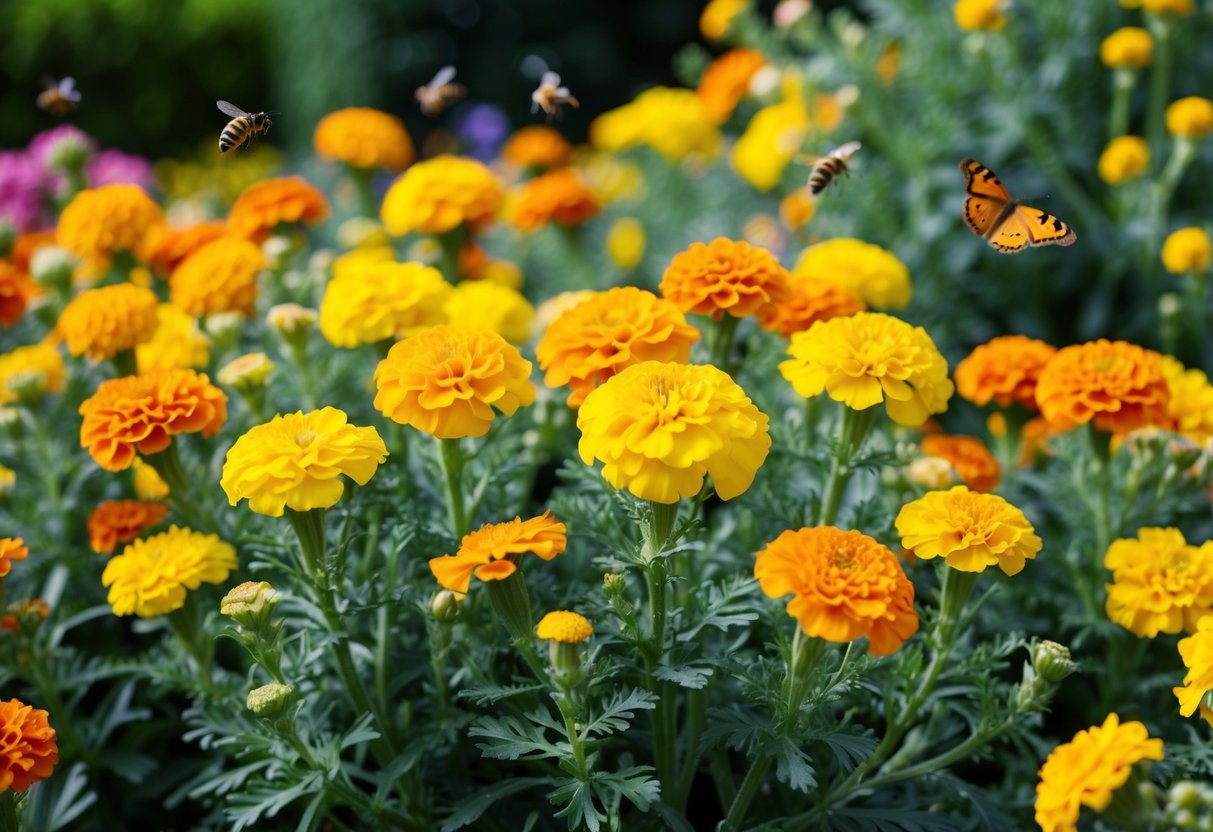
Marigolds offer a host of benefits beyond just their beauty. They help in gardens by attracting pollinators and serving as companion plants. They are part of the Asteraceae family, which includes useful varieties.
Companion Planting and Pollinators
Marigolds make excellent companion plants in your vegetable garden. They help deter certain pests, creating a safer environment for your vegetables. Their bright blooms attract pollinators like bees and beneficial insects. This not only helps marigolds thrive but also benefits other plants in your garden by promoting better pollination.
Including marigolds in your garden layout could mean more blooms and vegetables. This is especially true for varieties like Tagetes and Calendula, which belong to the Asteraceae family.
Edible and Medicinal Uses
You might find it surprising, but some marigold varieties are edible. For instance, Calendula officinalis, also known as pot marigold, can be used in salads or as a garnish. These edible marigolds add both flavor and color to dishes.
Beyond culinary uses, marigolds have medicinal properties. Calendula is often used in skincare products for its soothing effects. These marigolds can be made into herbal teas or salves that might aid in soothing skin irritations. Using marigolds this way connects you with a plant that is both useful and versatile.
Creative Ideas for Growing Marigolds
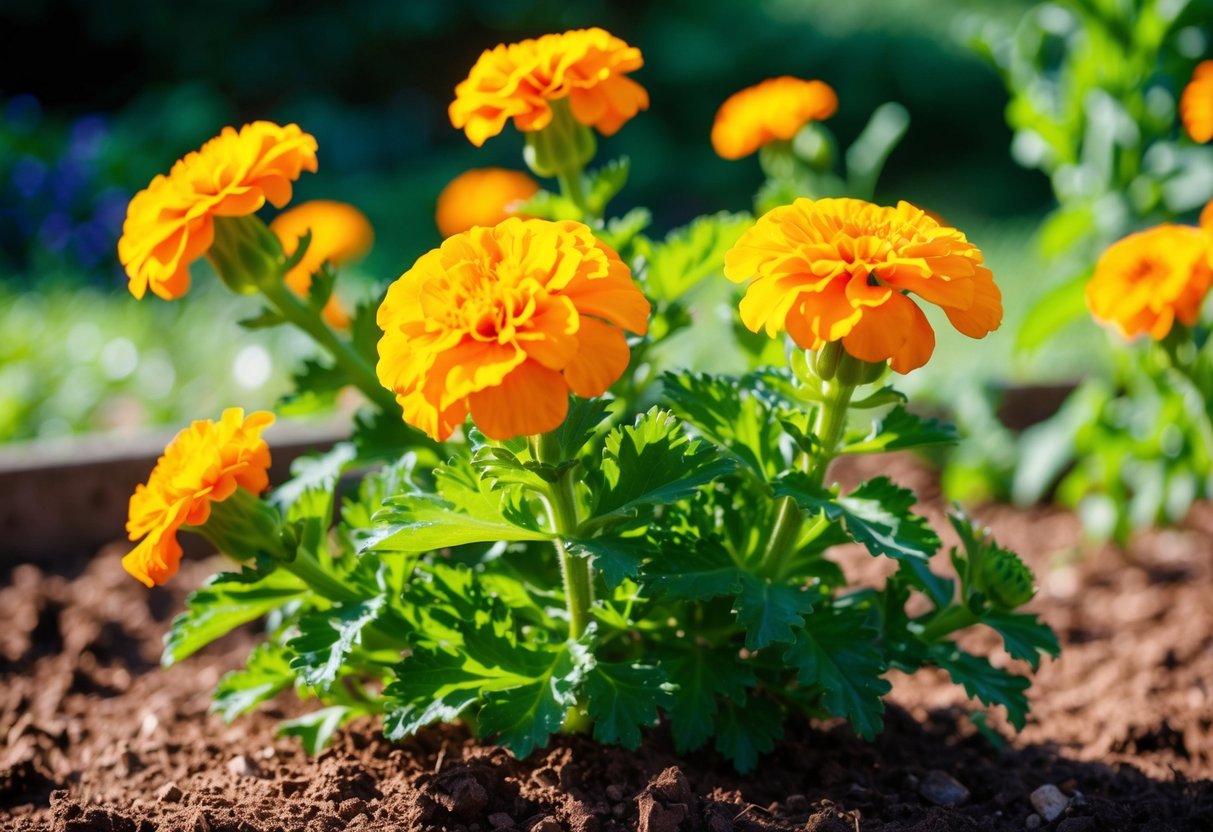
You can enhance your garden with vibrant marigolds through creative planting methods. Explore growing marigolds in containers for flexible options or incorporate them into your landscape design to attract pollinating insects and add color to your garden.
Marigolds in Containers
Growing marigolds in containers is a flexible way to add color to your patio or any small outdoor space. Choose pots with good drainage and fill them with a well-draining, sandy soil. This helps prevent soggy conditions, which marigolds dislike.
Place your container in a spot with plenty of sunlight, as marigolds love the sun. Water them when the soil feels dry. Container marigolds are great for decorative displays and can even be moved around to catch the best light throughout the day.
If you’re thinking of adding variety, consider mixing pot marigold with other flowering plants. This not only enhances your visual setup but also supports a diverse range of pollinating insects by providing multiple sources of nectar in one place.
Landscape Design with Marigolds
Incorporating marigolds into your landscape design is a brilliant way to create striking borders and attract beneficial insects. Use them as edging plants along pathways or flowerbeds. Their bright colors draw the eye and can highlight different areas of your garden.
Marigolds are known to repel pests and can be paired with vegetables like tomatoes and peppers for added protection. Consider alternating marigold types like French and African marigolds to create a dynamic garden display.
These flowers can also be part of a themed garden design. Try grouping them with other drought-resistant plants. This can create a low-maintenance area that thrives with minimal care while still providing plenty of vibrant blooms.







